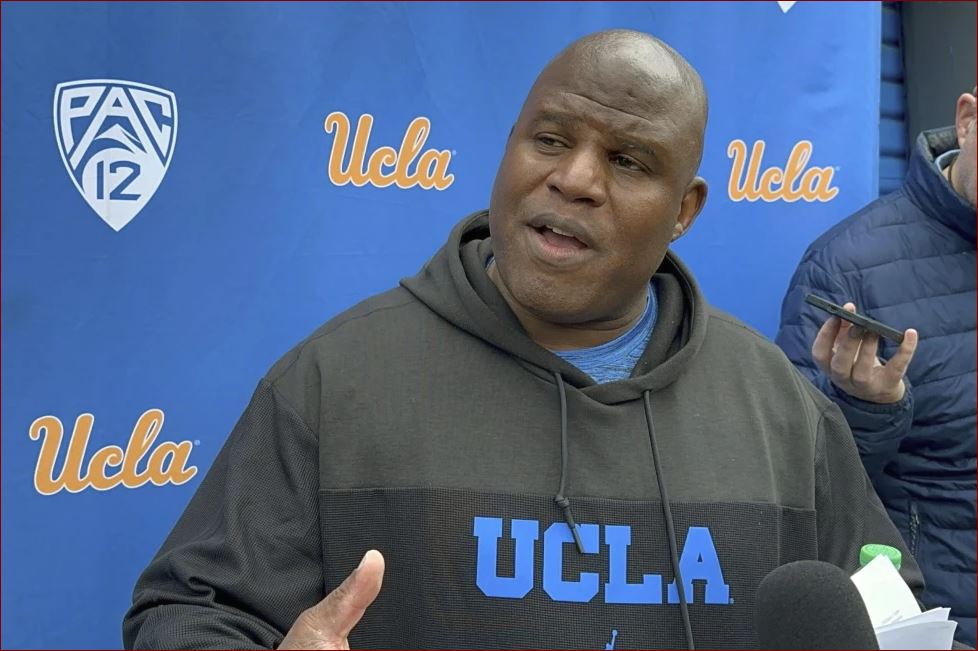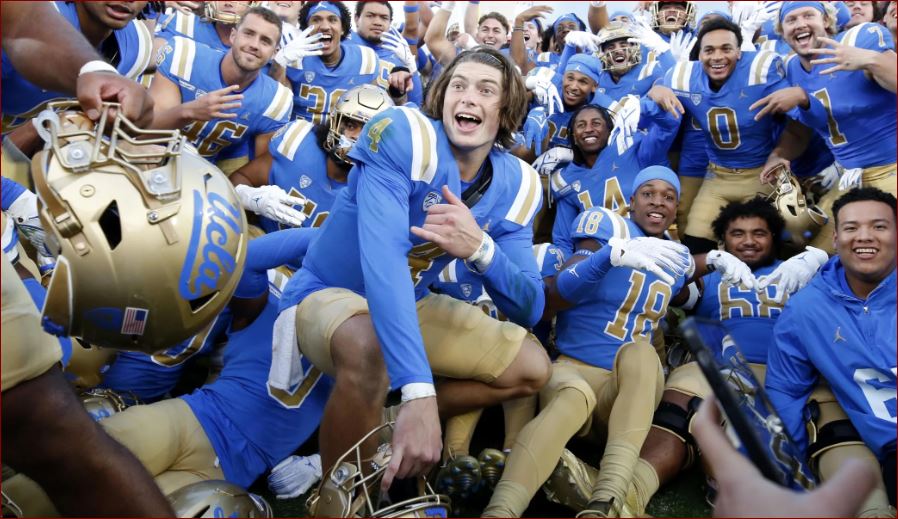
Amid the buzz surrounding UCLA Bruins head coach DeShaun Foster’s “freeze heard around the world” at last week’s BIG-10 Media Day, valuable insights emerged from Ethan Garbers and J. Michael Sturdivant regarding the subtleties of offensive coordinator Eric Bieniemy’s new philosophy, strategy, and scheme.

Here are three key insights from their discussion.
What UCLA Bruins Players (Ethan Garbers and J. Michael) Are Sharing About Eric Bieniemy’s New Offense

Ideas Over Formations
Everyone noted that Bieniemy’s offense relies on entirely new terminology, which players have spent much of spring and summer mastering. They talked about the complexity of this language, highlighting the different variations that a single concept can encompass.
While Chip Kelly is known for his innovative offensive strategies, he fundamentally conveyed his system through more visual methods. This is reflected in the numerous visual sideline posters that teams nationwide have used to imitate his fast-paced, spaced-out offensive style.
When players talked about Bieniemy’s new approach, it closely resembled how Chicago Bulls and Los Angeles Lakers players described Phil Jackson’s Triangle Offense. Both strategies focus on establishing fundamental concepts on the court that allow individual player variation and creativity to thrive.
This required a fresh way of breaking down information linguistically, which is why many thought it took about a year to fully master Jackson’s offense.
While Jackson emphasized floor balance, Bieniemy seems to prioritize putting stress on the defense. UCLA fans can only hope that their determined Bruins achieve similar outstanding success.
Versatility
Listening to the players and analyzing Bieniemy’s offense from his time with the Kansas City Chiefs to the Washington Commanders reveals a central theme of versatility. He can just as easily deploy five-wide empty formations as he can use 11 (one running back, one tight end) or 22 (two running backs, two tight ends) personnel.
His offenses frequently utilize various running schemes, including zone, gap, and power. Additionally, offensive linemen may align with either narrow or wide splits, showcasing their adaptability.
Thus, the Bruin players who will be most successful under this new regime are the ones who can do multiple things well, have several skill sets, and demonstrate a willingness to expand their value.
Rico Flores, Keegan Jones, Spencer Holstege, and Sturdivant come to mind as players most likely to benefit from this approach.
Pass-Heavy
Bieniemy has never had a running back rush for over 1,000 yards or carry the ball 200 times in a season, and last year, his quarterback, Sam Howell, led the NFL in pass attempts while with the Commanders. In contrast to Kelly, who emphasized a structured running game with a feature back, Bieniemy prefers a running-back-by-committee strategy that complements a frequent short passing game.
This aligns with Garbers highlighting the significance of Keegan Jones returning to the team in the spring after considering a transfer to UConn, emphasizing the senior’s potential impact as “huge.”
Bieniemy’s offensive style may reminiscent of Joe Tiller’s early 2000s Purdue offenses, which featured Drew Brees and were famously described as “basketball on grass.”
It will be intriguing to see how the development of the offensive line will enable Bieniemy to enhance all facets of his offensive strategies.
These insights came from the Bruins’ discussions last week, with just about a month until the season opener in Hawaii.

Leave a Reply